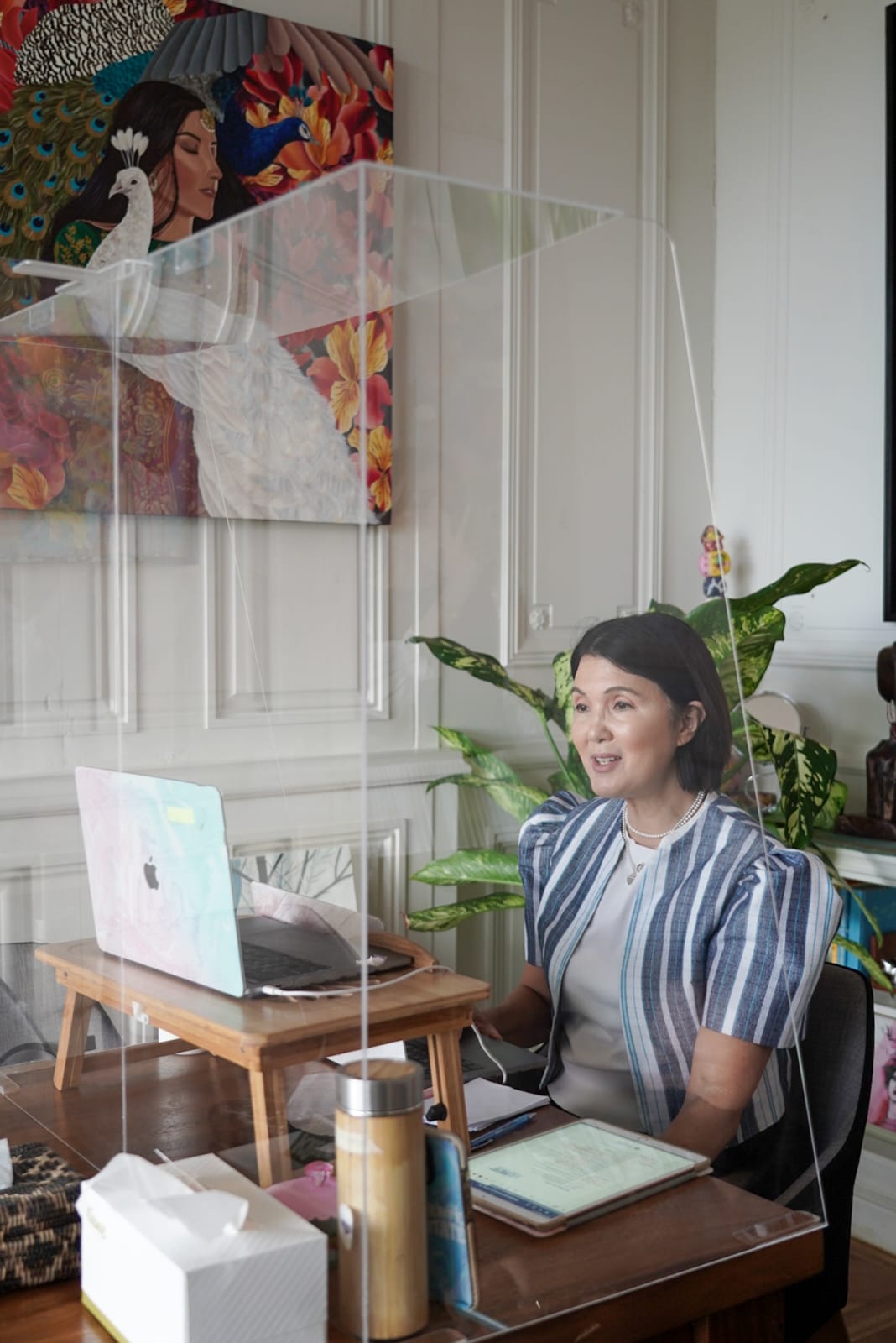Speech of Senator Pia S. Cayetano
Chairperson, Senate Committee on Sustainable Development Goals, Innovation, and Futures Thinking
World Summit of the Committees of the Future
Helsinki, Finland
Thank you very much. Good morning to you. It is late afternoon in the Philippines now. I am very excited to be present virtually, although I would have preferred to have the opportunity to be there, except that the invitation comes at a time when the Philippines is in the middle of our budget debates. And it posed great difficulties for me to manage the budget committees that I chair here in the Philippines, so I have to be content to be present virtually.
My name is Pia Cayetano, I am a senator from the Philippines. And I am extremely pleased to join colleagues from all over the world in discussions on what parliaments are doing for futures thinking.
I had the opportunity to listen to the speakers before me and have already learned a great deal in just the last hour or two. So let me share about our work.
In my country, I personally pushed for the creation of the Senate Committee on SDGs, Innovation, and Futures Thinking in the previous Congress. So this started in 2019. I chaired that first Committee from 2019-2022 and I currently chair it in this Congress.
This was the very first time that the Senate of the Philippines had such a committee, which opened the discussions on the role of futures thinking and what it can do for legislation and policy-making
This actually was inspired from the practice in Finland on the Futures Committee, which I believe started way back in 1990.
So what we do in the Committee is..precisely to track where we are with our SDGs, prepare for various futures, and shift our mindset to futures thinking as a major policy reform.
What I do as the Chairman of this Committee is make interventions on almost any piece of legislation in the Senate, including the national budget, to prepare for various futures and shift to a futures-oriented mindset, through the use of strategic foresight and futures thinking tools.
So, I’d like to give now examples of our work.
Before the pandemic and during the pandemic, the committee held a series of hearings and invited futurists from all over the world to discuss the different futures of the Philippines beyond the pandemic, primarily on education, work and health.
On the national budget, I happen to be the Senior Vice Chair for the Committee on Finance and I handle the national budget for education and health sectors. I have been working on future-proofing these budgets and using strategic foresights.
In the course of my work on the budget, we have provided funding for Futures Offices in: Department of Education; Department of Health, and Department of Science and Technology. A Sub-Committee on SDGs under the National Economic and Development Authority (NEDA) was also created.
We provided funding for research on the futures of food systems and food security, in 4 State Universities and Colleges (SUCs). I felt that this was extremely important because it is these universities that will be providing us with the necessary research. We also provided funding for the futures of food production, and this was given to the DOST.
We also pushed to grant the Development Academy of the Philippines additional funds to support lifelong learning and capacity building in strategic foresight for government officials and employees. Again, this is very important because in our work in Congress, we need to also ensure that these policy directions that include futures thinking are happening on the ground.
So on hearings in aid of legislation, we filed a Senate Resolution in 2020 to investigate how COVID-19 affected various sectors and their action plans to adapt, innovate and prepare for all possibilities and outcomes post-pandemic.
We had our Senate hearing, and we actually invited Dr. Tuomo Kuosa and Saku-Juhani Koskinen, and we had the Futures Platform from Helsinki, Finland. They discussed their Foresight Radar, which charts how various trends and phenomena will be impacted by certain events. Among the tools were the futures triangle, which helped the Committee in its work in advancing futures thinking in policy-making.
On the futures of health, in our hearings, we ended up with conclusions that you would think are quite simple and common, but sometimes we go through this exercise just to emphasize what should already be obvious.
And these were for the delivery of health services, the focus would be on: primary health care; patient-centered care; increased use of technology (which includes artificial intelligence, use of simulations in medical schools); engagement with different communities; and prioritizing holistic health, wellness and prevention.
I’d like to go to another topic, on the futures of cities and transportation. Actually, before we even had the Committee on Futures Thinking, I had already filed over 10 years ago a bill on sustainable transportation, which emphasized more mass transportation and included mobile transportation.
So in the last Congress, which was 3 years ago, 2019-2022, I authored and sponsored the Safe Pathways Network Bill, and we actually passed this in the Senate but it did not pass in the House of Representatives. So in this Congress that started this year, I refiled the bill and upon further study, called it a name that was more easily understandable by the public, and it is now called the Walkable and Bikeable Communities Bill. This has also passed in the Senate.
This is very exciting for us because for those of you who have been to many Asian countries, not all, but Asian countries including mine, we have a very high population, there is still a heavy dependence on cars. Of course there are public transportation [systems], but these are not enough. So when you look into the future of transportation, you can clearly see the need for investments in public transportation, and also the recognition that with sustainable city models, many will travel very short distances, and therefore, the use of safe pathways networks and interconnected networks of streets and slow streets, people can be more mobile on their feet, on bikes, to allow them to travel very short distances.
Also filed by this representation are bills that support sustainable cities in the future, such as the Sustainable Cities and Communities Act. This is something that I hope to work on more in this Congress.
I’d like now to go to the futures of education. During the pandemic, one of the major outputs of our Committee was the Futures of Education Committee Report. I am happy to share this with anyone who is interested, as I am happy to also get samples of the bills that the colleagues who presented before me have mentioned in your presentations.
So our Futures of Education reported on how we can balance the use of technology in the delivery of education, but how we also need to strike that balance and not be reliant just on technology, because face-to-face interaction and the use of interpersonal skills must also be developed. I remember attending a conference, where the emphasis was on science and technology, and one of the speakers recognized that, and if I am not mistaken, the World Economic Forum, stated that it doesn’t mean that all jobs in the future will be on science and technology. We would also need students, young people, young adults, to reinvent themselves in the areas of creativity and communication.
So let me now go on into future challenges and opportunities. Personally, I have an interest in the futures of water. The growing global population has increased the demand for fresh drinking water. No less than UNESCO states that 80% of the world is exposed to water insecurity, with an impending water crisis to emerge in 2070. With water being vital to all forms of life, how do we meet the water requirements needed to support living organisms and their ecosystem? We will recall, in history, societies were built near water sources, rivers, oceans, and in a way, we go full circle because without this access to clean water, it will create problems for us.
I also like us to look into the future of food. According to the World Bank’s Food Commodity Price Index, food prices around the world have increased by 80%, compared to two years ago. So COVID-19 has exposed the vulnerability of our supply chain, this continues to be a problem for many countries.
So I already mentioned my interest in the future of cities. There are models in different parts of the world that we can use for our particular needs. And of course, I already mentioned the futures of health. These are all important, the future of education, and how we need to transform our education to meet the needs of the work demands.
So in conclusion, there is much to be done. I am extremely happy to be in the midst of like-minded parliamentarians and policymakers, with the view of using futures thinking tools and strategic foresight to really plot what we want for the future generation of our countries and of the world because we all live together. It is my goal that the future children, the young children, have a better home. We are guided by the principle of intergenerational fairness, where we put ourselves 20, 30, 50 years ahead and see if we are prepared for that future. Thank you very much. #


Leave a Reply